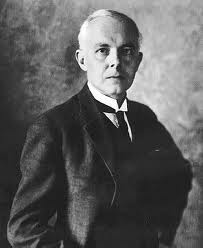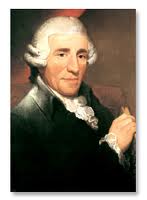March 26, 2012.Bartók and Haydn.The anniversary of the great Hungarian composer Béla Bartók was this past Sunday, March 25.He was born in 1881 in what was then the Dual Monarchy of Austria and Hungary, in a small town of Nagyszentmiklós (Great Saint Nickolas in Hungarian; after World War I as the town, and most of the regions of Banat and Transylvania reverted to Romania, its name was changed to Sânnicolau Mare, which means exactly the same, only in Romanian).When he was five, his mother began giving him regular piano lessons.At the age of 19 he moved to Budapest and started lessons with István Thomán, a pupil of Franz Liszt.While there, he met Zoltán Kodály who became his lifelong friend.By 1907 Bartók was teaching piano at the Royal Academy.Among his students were Fritz Reiner and Georg Solti, two Hungarian Jewish kids who became world-famous conductors and whose careers pinnacled at the Chicago Symphony Orchestra (Reiner was the CSO’s music director from 1952 to1963, Solti from 1969 to 1991).Both were champions of Bartók’s music.The period between the two world wars was tremendously productive for Bartók.Starting with the ballet The Miraculous Mandarin in 1918, he wrote string quartets, two piano concertos, Music for Strings, Percussion and Celesta, and a large number of piano pieces and songs.In 1940 Bartók, who was opposed to Nazism, emigrated to the US.He never felt comfortable in America, and was not as productive as in previous years, although not long before his death he created one of his masterpieces, Concerto for Orchestra.The last years of his life Bartók was quite ill; in 1944 he was diagnosed with Leukemia. He died on September 26, 1945 in New York.His remains were transferred to Hungary and he was given a state funeral in 1988.We’ll hear Romanian Folk Dances, based on the folk tunes of Transylvania that Bartók himself collected around 1910; it is performed by Camerata Chicago, Drostan Hall conductor (here).
LikeBartók,Franz Joseph Haydnwas also born in Austria-Hungarian realm, but on the Austrian side, in a small village of Rohrau near the border with Hungary.His birthday isMarch 31, 1732.Haydn’s parents noticed his musical talents when he was a child and sent six year old Josef to live with their relative, a schoolteacher and choirmaster in Hainburg, a small town nearby.He lived in poverty and hunger but learned to play the harpsichord and violin.He also had a good voice, which brought him to Vienna as a chorister at the St. Stephen Cathedral, the musical center of the Empire.In 1749, as he lost his boy soprano voice, Haydn was kicked out of the choir.For the next 12 years he lead an uneasy life of a freelancing music teacher, accompanist, organ player, and also a composer.He eventually was hired by the Esterházy, one of the wealthiest families in the empire.He soon became the Kapelmeister with many responsibilities as composer, player and person in charge of the orchestra.Haydn lived in the Esterházy’s estates in Eisenstadt and later in the newly built grand estate of Esterháza.It was there that Haydn composed three piano sonatas, numbers 25, 26, and 27 in the Hoboken catalogue.They’re performed by Nina Tichman, an American pianist living in Germany.Sonata 25 in E-flat major is here, number 26 in A Major is here, and number 27 G major is here.
Bartók and Haydn 2012
March 26, 2012. Bartók and Haydn. The anniversary of the great Hungarian composer Béla Bartók was this past Sunday, March 25. He was born in 1881 in what was then the Dual Monarchy of Austria and Hungary, in a small town of Nagyszentmiklós (Great Saint Nickolas in Hungarian; after World War I as the town, and most of the regions of Banat and Transylvania reverted to Romania, its name was changed to Sânnicolau Mare, which means exactly the same, only in Romanian). When he was five, his mother began giving him regular piano lessons. At the age of 19 he moved to Budapest and started lessons with István Thomán, a pupil of Franz Liszt. While there, he met Zoltán Kodály who became his lifelong friend. By 1907 Bartók was teaching piano at the Royal Academy. Among his students were Fritz Reiner and Georg Solti, two Hungarian Jewish kids who became world-famous conductors and whose careers pinnacled at the Chicago Symphony Orchestra (Reiner was the CSO’s music director from 1952 to1963, Solti from 1969 to 1991). Both were champions of Bartók’s music. The period between the two world wars was tremendously productive for Bartók. Starting with the ballet The Miraculous Mandarin in 1918, he wrote string quartets, two piano concertos, Music for Strings, Percussion and Celesta, and a large number of piano pieces and songs. In 1940 Bartók, who was opposed to Nazism, emigrated to the US. He never felt comfortable in America, and was not as productive as in previous years, although not long before his death he created one of his masterpieces, Concerto for Orchestra. The last years of his life Bartók was quite ill; in 1944 he was diagnosed with Leukemia. He died on September 26, 1945 in New York. His remains were transferred to Hungary and he was given a state funeral in 1988. We’ll hear Romanian Folk Dances, based on the folk tunes of Transylvania that Bartók himself collected around 1910; it is performed by Camerata Chicago, Drostan Hall conductor (here).
and Hungary, in a small town of Nagyszentmiklós (Great Saint Nickolas in Hungarian; after World War I as the town, and most of the regions of Banat and Transylvania reverted to Romania, its name was changed to Sânnicolau Mare, which means exactly the same, only in Romanian). When he was five, his mother began giving him regular piano lessons. At the age of 19 he moved to Budapest and started lessons with István Thomán, a pupil of Franz Liszt. While there, he met Zoltán Kodály who became his lifelong friend. By 1907 Bartók was teaching piano at the Royal Academy. Among his students were Fritz Reiner and Georg Solti, two Hungarian Jewish kids who became world-famous conductors and whose careers pinnacled at the Chicago Symphony Orchestra (Reiner was the CSO’s music director from 1952 to1963, Solti from 1969 to 1991). Both were champions of Bartók’s music. The period between the two world wars was tremendously productive for Bartók. Starting with the ballet The Miraculous Mandarin in 1918, he wrote string quartets, two piano concertos, Music for Strings, Percussion and Celesta, and a large number of piano pieces and songs. In 1940 Bartók, who was opposed to Nazism, emigrated to the US. He never felt comfortable in America, and was not as productive as in previous years, although not long before his death he created one of his masterpieces, Concerto for Orchestra. The last years of his life Bartók was quite ill; in 1944 he was diagnosed with Leukemia. He died on September 26, 1945 in New York. His remains were transferred to Hungary and he was given a state funeral in 1988. We’ll hear Romanian Folk Dances, based on the folk tunes of Transylvania that Bartók himself collected around 1910; it is performed by Camerata Chicago, Drostan Hall conductor (here).
Like Bartók, Franz Joseph Haydn was also born in Austria-Hungarian realm, but on the Austrian side, in a small village of Rohrau near the border with Hungary. His birthday is March 31, 1732. Haydn’s parents noticed his musical talents when he was a child and sent six year old Josef to live with their relative, a schoolteacher and choirmaster in Hainburg, a small town nearby. He lived in poverty and hunger but learned to play the harpsichord and violin. He also had a good voice, which brought him to Vienna as a chorister at the St. Stephen Cathedral, the musical center of the Empire. In 1749, as he lost his boy soprano voice, Haydn was kicked out of the choir. For the next 12 years he lead an uneasy life of a freelancing music teacher, accompanist, organ player, and also a composer. He eventually was hired by the Esterházy, one of the wealthiest families in the empire. He soon became the Kapelmeister with many responsibilities as composer, player and person in charge of the orchestra. Haydn lived in the Esterházy’s estates in Eisenstadt and later in the newly built grand estate of Esterháza. It was there that Haydn composed three piano sonatas, numbers 25, 26, and 27 in the Hoboken catalogue. They’re performed by Nina Tichman, an American pianist living in Germany. Sonata 25 in E-flat major is here, number 26 in A Major is here, and number 27 G major is here.
Franz Joseph Haydn was also born in Austria-Hungarian realm, but on the Austrian side, in a small village of Rohrau near the border with Hungary. His birthday is March 31, 1732. Haydn’s parents noticed his musical talents when he was a child and sent six year old Josef to live with their relative, a schoolteacher and choirmaster in Hainburg, a small town nearby. He lived in poverty and hunger but learned to play the harpsichord and violin. He also had a good voice, which brought him to Vienna as a chorister at the St. Stephen Cathedral, the musical center of the Empire. In 1749, as he lost his boy soprano voice, Haydn was kicked out of the choir. For the next 12 years he lead an uneasy life of a freelancing music teacher, accompanist, organ player, and also a composer. He eventually was hired by the Esterházy, one of the wealthiest families in the empire. He soon became the Kapelmeister with many responsibilities as composer, player and person in charge of the orchestra. Haydn lived in the Esterházy’s estates in Eisenstadt and later in the newly built grand estate of Esterháza. It was there that Haydn composed three piano sonatas, numbers 25, 26, and 27 in the Hoboken catalogue. They’re performed by Nina Tichman, an American pianist living in Germany. Sonata 25 in E-flat major is here, number 26 in A Major is here, and number 27 G major is here.